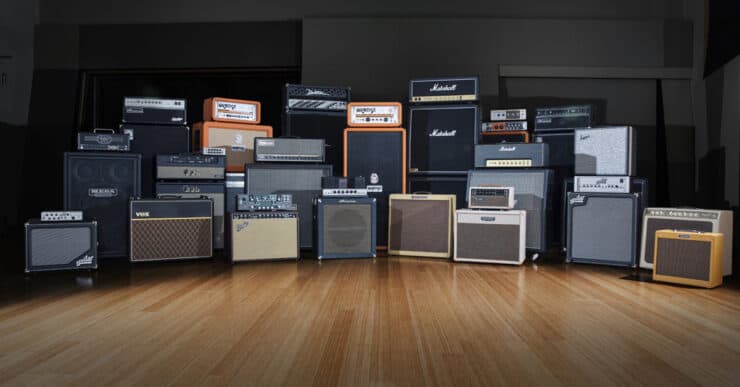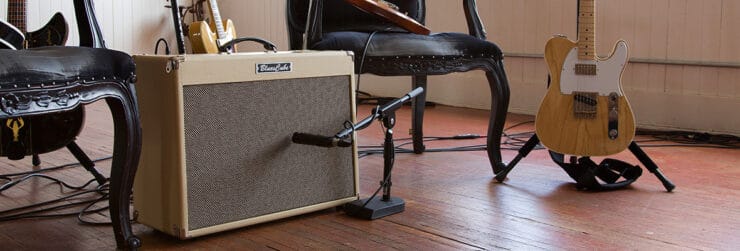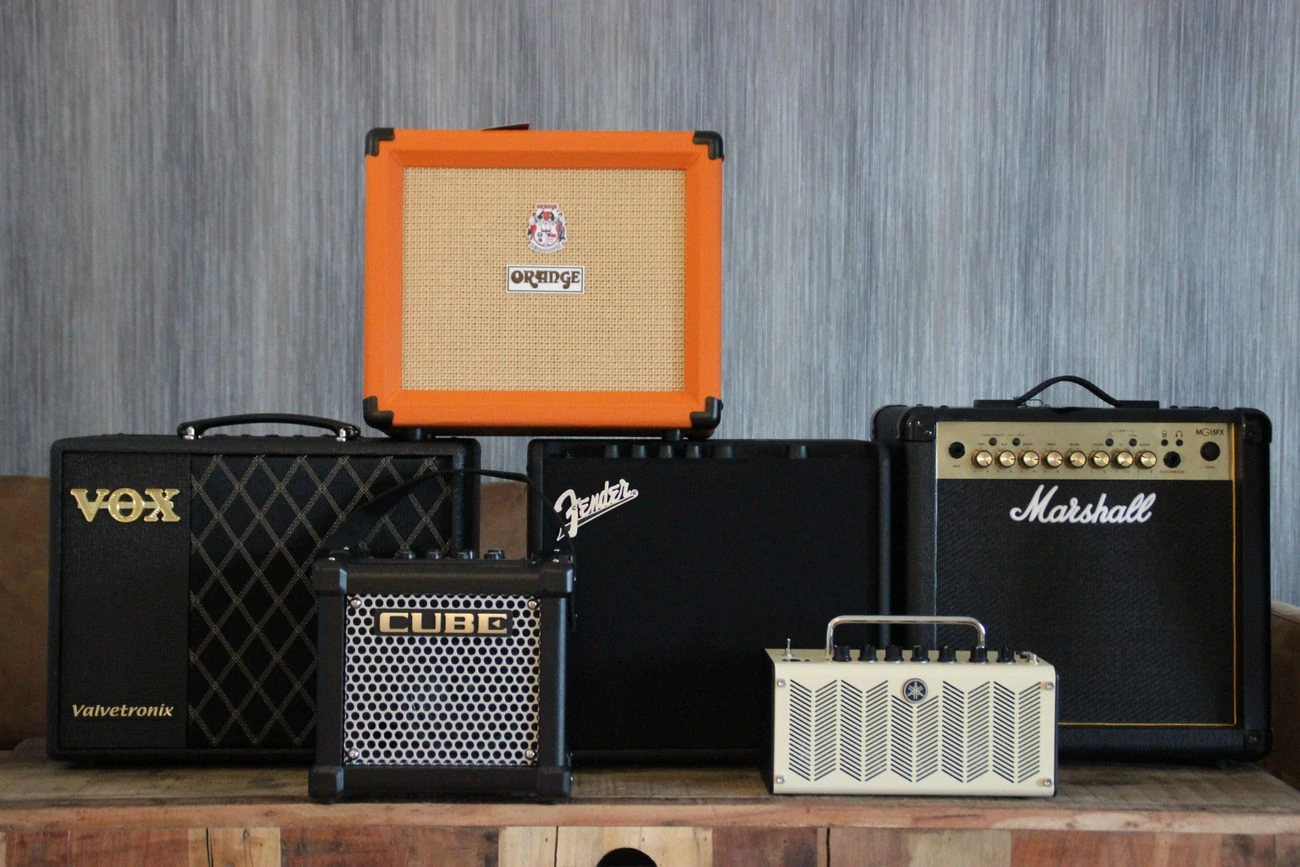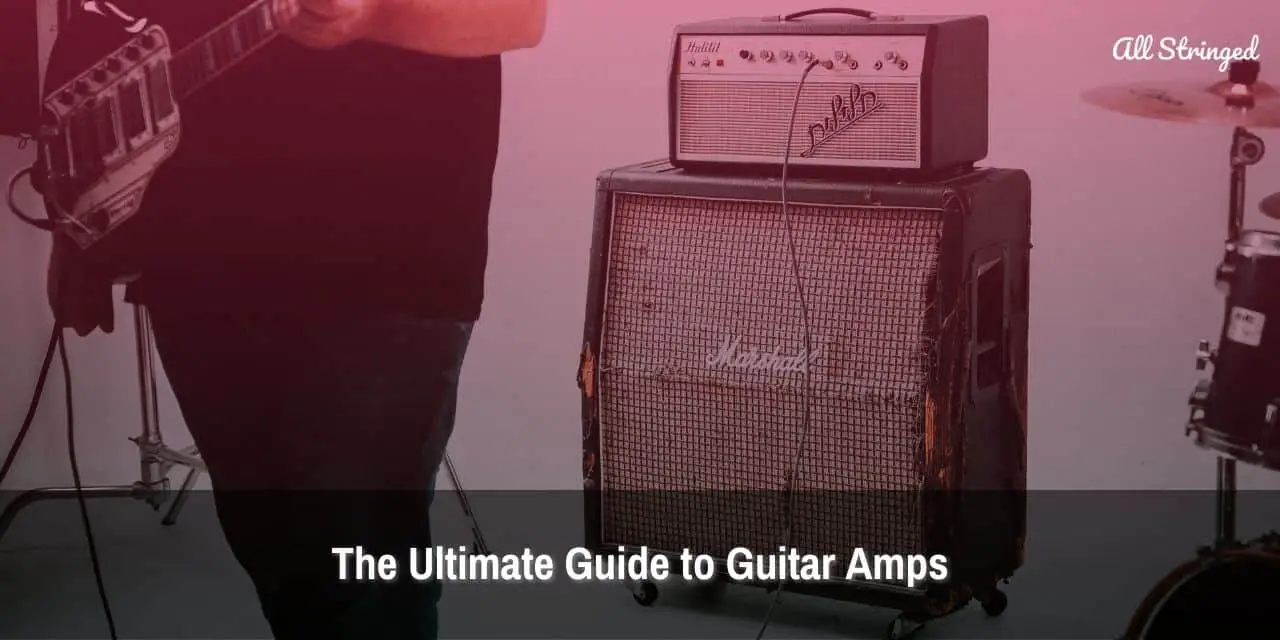Are you ready to unlock the full potential of your guitar sound? With the ultimate guide to guitar amps and beyond, you can take your sound to the next level. Whether you’re a beginner, intermediate, or advanced player, this comprehensive guide will help you discover the perfect amp and sound for your skill level and desired tone. With tips and tricks from guitar pros, you can unleash your sound and stand out from the crowd. So grab your guitar and let’s get started!
What is a guitar amp?
A guitar amp is a vital component needed for playing an electric guitar. Plugging your guitar into an amp will allow you to unleash the full potential of your guitar’s sound. Not only does a guitar amp allow the notes and chords to ring out, but it’ll also provide the guitarists with a mechanism to alter the sound and play around with effects.
An amplifier is a broad spectrum rather than a device used for making guitars sound good for metal or for turning reverb up or down. Many amps are configured differently, which will depend on their primary purpose. In a general sense, a guitar amp is an electronic circuit that strengthens the power of the signal. An amp can either be an independent piece of gear or an electric network separate from the device.

Whether you’re practicing in your room or playing a gig at a small venue, there is a guitar out there for every occasion. Finding your ideal tone and piecing together your guitar rig that functions exactly how you want it to sound like will be one of the most satisfying and rewarding things to do. To achieve that, you’ll need to find the perfect guitar amp.
How to set up a guitar amp
Generally, to get the perfect sound from a guitar amp, you will require two parts – the amp and the speaker cabinet. The amp takes the guitar signal and amplifies it such that it can be sent through the second part, which will be the speaker cabinet.
The guitar amp and speaker combination will come in two formats. First, you’ll need to know what is called a combo. This is where both the amp and speaker come housed in a single box. Secondly, there is the head and cab setup. This is where the amp is in its own self-contained box and can be easily paired with a separate speaker cabinet that you like.
ALSO READ: Top 15 Best Guitar Amp Reviews
Different types of guitar amps
So, now you know that your amp needs to be paired with a speaker. Over the years, as both technology and consumer demands have progressed, it has become to choose the type of amp. There are many different types of guitar amps that you should consider when deciding what works best for you –
#1. Tube amplifiers
A tube amp is the traditional type of guitar amp, and it utilizes vacuum tubes (also known as valves). These valves are responsible for powering two separate parts of the amp. The first is the preamp section, which although can be involved, you can think of it as giving the tone its personality and character. Secondly, there is the power amp section. This will take the output of the preamp and boost it to drive the speakers.
#2. Solid state amplifiers
The solid-state amp forgoes the use of vacuum tubes and instead uses electronic circuit boards for producing its sound. There are many benefits to this, they’re generally more durable as they do not use the more fragile glass vacuum times. Moreover, they are also quite cheaper to produce. However, many guitarists prefer the warm and dynamic response of a tube amp over solid-state amps. There’s a general sentiment in the guitar community that solid-state amps do not sound as desirable as tube amps.
#3. Hybrid amplifiers
Hybrid amps draw upon the best of the tube and solid-state amps. These amps use a tube-driven preamp section for getting the warmth and dynamic response but will use a solid-state power amp, which is cheaper to produce and weighs less. There are many rare cases where they’ll be flipped, and it is the preamp which is solid-state with a tube-driven power amp.
#4. Modeler/Profiler
This type of amp is the one that has seen the most changes over the last decade as computer technology and digital signal processing have progressed a lot. A modeling amp is one that uses a digital code and microprocessor for recreating the sound of high-end amps right down to the individual component level at a cheaper cost. Originally, they didn’t sound great but over the years, they’ve substantially improved and are commonplace in many professional musicians’ setups.
#5. Pedal (amp in a box)
The simplest way of thinking of pedal amps will be that the manufacturers took the preamp out of a full amp and put it in a convenient stompbox. They have proven to be quite popular for their small form factor and portability.
There are many variations on the market, sometimes the preamp could be a tube, while the other times it could be digital. Some may also have a power amp built-in, whereas some may forgo the power amp for a digital cabinet loader. Meanwhile, some of them try to emulate rigs with various routing features and in-built effects.
#6. Rackmount
Rackmount guitar amps were quite common during the 90s, but they have unfortunately waned in popularity as the pedal format has been dominating the market. The word “rack” refers to the equivalent that has a universal size of 19” as the manufacturers have to adhere to this standard such that you can pick and choose the items and components to build the perfect rig.
This has allowed for ultimate customization, as you’ll be able to purchase a preamp from one company and a power amp from another company. This way, you’ll be able to build a rig that is unique to you.
#7. Amp sims
Similar to modeling amps, amp sims have seen a massive surge in popularity lately as technology has helped this format to start holding its own. Earlier, this format didn’t use to sound all that great. These days, it isn’t out of the ordinary to find high-end amp sims to be used on top-end professional music productions. They’re basically software recreations of amplifiers that you’ll be able to run on your computer. You will then be able to plug your guitar into the PC using an audio interface and play them like a real amplifier.
Preamp vs. Power amp – Get the most out of your guitar amp
Preamp
A guitar preamp serves multiple functions. The first one will be to take the guitar’s signal, which when taken straight out of the instrument is pretty quiet and weak, and will bring it to what is known as “line level”. The signal then becomes loud enough to be sent to other equipment, either to the power amp, to a mixer, or to a cabinet simulator. Its other function will be tone shaking as most preamps come with at least a simple three-band EQ comprising of bass, treble, and mid. If your preamp has distortion, then it’ll be applied as well.

Power amp
So, now that you have taken the quiet raw guitar signal and the preamp has boosted the signal, EQ’d it, and added some distortion, what next?
If you sent the preamp signal to a big speaker cabinet, it simply won’t have enough juice for driving it. This is where the power amp will come into the picture. It’ll take the preamp signal and amplify it such that it can drive the speakers.
The power amp is essentially the final section of an amp. The power amp can color and distort the tone as well, which is an important thing to consider when you’re deciding which one is right for you.
Read our article about 10 Must-Have Guitar Gear here!
Guitar amp tone and effects
When you’re choosing a guitar amp, you should know the type of tone and effects that you want to use. Most amps come equipped with standard knobs and basic tones that you can adjust. Others have more effects built-in that give you many more options to experiment with. When shopping for an amp, there are a few tones and effects to keep in mind.
#1. Equalization controls
EQ or Equalization controls on the amp refer to a series of knobs that’ll allow you to control the treble, bass, and midrange frequencies. How you’re configuring these controls will help you tweak the tone. Equalization will help you adjust the tone to help you achieve the right sound for your environment. The same tone and EQ knob configuration that works well for a small practice space might vary from the EQ balance that you’ll require in a larger environment.
#2. Distortion
The gain knob on your guitar amp will help you control the level of distortion. The higher you’re cranking the gain knob, the greater will be the level of distortion. While you can make use of a distortion pedal, the gain knob will allow you to warp your sound without it.
#3. Reverb
Reverb refers to the amount of reverberation or acoustic echo that your amp gives off when it is used. Reverb on an amp will allow you to get a big sound that fills up space from a smaller practice amp.
#4. Digital effects
Many modern amps come equipped with a wide variety of digital effects that help in producing a desired tone without needing to buy and plug in a variety of pedals. Previously, most practice amps used to be quite basic and included only EQ controls or a handful of effects like reverb or gain.
However, innovation and modern technology have made it possible to pack in a greater variety of digital effects built into the smallest of amps. You might not require a full suite of effects at your disposal when you’ve just started to learn to play. However, having a guitar amp that can give you the ability to experiment with different effects and tones can motivate you to continue practicing and carving your own unique sound.
#5. Multiple channels
Some guitar amps are single channels, while others can have anywhere from 2–4 channels. Multiple-channel amps are ideal for guitarists who have to switch between different tones. This is generally achieved through a footswitch that allows you to toggle between different channels. For instance, you might keep one channel for clean tones and use a separate channel for effects like overdrive or a distortion pedal setup of your own configuration.
How to choose a guitar amp?
#1. Consider the type of music you’ll be playing
The type of music you’ll be playing will greatly influence your choice of guitar amp. Not just the style of music you’ll play, but your personal playing style will also dictate the type of amp you should go for.
When asking yourself for the perfect amp for you, consider the type of music you love to play. Explore amps that boast features that’ll give you the sound you aspire to produce. Many guitar amps come designed with versatility in mind, which boasts a wide variety of built-in options for tones and effects that you can dial in for producing a sound that feels right at home with your favorite genres.
For instance, if you play pop, jazz, or country, an amp capable of delivering a crisp, clean sound will be ideal. If you want to have more crunch or fuzz, you should go for an amp with pre-loaded effects. If you are still experimenting with the sound, or you aren’t certain, you should look for a guitar amp that can give you the best of all worlds.
A bass amp is designed to give you more of the low-end rumble, adjust the tone using presets and built-in effects, and make use of many features baked into electric guitar amps. While you can certainly play bass using a guitar amp, a bass amp is designed specifically for pumping out your instrument’s sound without it being muddied. Typically, a bass amp comes with a bigger speaker and higher wattage for output.
If your guitar preference happens to be an acoustic-electric guitar, you should go for an amp designed to enhance the tones of an acoustic guitar. This will allow the natural resonance to pour through. Acoustic guitar amps aren’t usually equipped with the full range of tones and presets that many electric guitar amps include. However, some of them have built-in reverb for bringing out the acoustic flavor and amplifying it. There is also a looper that allows you to layer the sound. Some acoustic amps can even double as a PA system or have a second channel for plugging in a microphone for a solo singer-songwriter performance.

#2. Consider the portability and amp size
When you’re choosing a guitar amp, you should keep in mind where you will be practicing. If you live with other people or in a small apartment, you should consider an amp that has a headphone jack that allows you to hear the full power of the sound without disturbing your neighbors.
When you are starting your journey, a smaller amp for your guitar might be just what you need. Generally, practice amps aren’t more than 8 to 12 inches. Smaller-sized amps will be ideal as you can pack them and take them to practice sessions. This will eliminate the need for carting around heavy equipment. Smaller-sized practice amps also come equipped with built-in effects. This means you aren’t sacrificing versatility for a more portable size.
#3. Consider the wattage and amp volume
The size of the amp and its wattage go hand-in-hand. Smaller practice amps come with power between 10 and 40 watts. They are great when you’re practicing at home or in a small room by yourself.
If you step up in size, medium-sized amps are well suited for practicing with others or even small-sized venues if you are playing shows. Medium-sized amps generally offer between 50 and 100 watts of power. If you are playing with others, a practice amp will not cut it, as your guitar will have to compete with the bass and drums in your group. Having more wattage and volume for adjusting when playing with other musicians will be key.
If you have to play in medium-to-large-sized venues, you will want to look for an amp that has a higher wattage – between 100 and 200 watts. Keep in mind, some of the amps can also go up to 300 watts. The larger, more powerful amps are designed for working with bigger venues, which will help you fill-up the space with sound based on acoustic principles.
#4. Consider the material
The outside casing of the amp will also play a major role in producing a specific sound. While the size of the amp’s speaker and its electronic components help in defining what comes out of the guitar, so will its cabinetry. The “cabinet” is essentially the outer casing of the amp that holds everything together.
Wooden cabinets like amps with a pine cabinet will provide less sound distortion when compared to plastic. While amps having a plastic casing might be lighter in weight and much easier to lug around, amps that have a wooden casing will give a clearer sound. You can look at pianos and acoustic guitars if you want an example of why a wood casing will help your sound ring out true.
Although higher-end amps might be made from expensive woods like pine, there are many amps that use more affordable wood composites capable of producing excellent sound quality. Aside from the material of the cabinet, you will also want to check out the back of your amp. See if it is enclosed all the way around or is it open.
If you’re looking for a more natural sound, an open back cabinet will allow the sound to spill out of the back instead of compressing it tightly. This will be great for higher frequencies and guitar solos that are played further down the fretboard.
Closed back cabinets will concentrate on the sound and push it forward. This will create a more compressed sound that is ideal for mid-range or low-end sounds, like if you are playing bass or crave a thicker, heavier tone.
FAQs
What are the different types of guitar amps?
There are several types of guitar amps available, including solid-state amps, tube amps, modeling amps, hybrid amps, and portable amps. Each type of amp has its own unique sound, features, and benefits, so it’s important to consider which type of amp is best for your needs.
What are the advantages and disadvantages of each type of amp?
Solid-state amps are known for their affordability, durability, and reliability. However, they may lack the warmth of other types of amps and may not produce classic amp tones. Tube amps are known for their rich and warm sound and highly responsive nature, but they can be expensive and require maintenance. Modeling amps offer versatility and the ability to simulate classic amp tones, but may not sound as authentic as tube amps. Hybrid amps offer the best of both worlds, but may not be as versatile as modeling amps. Portable amps are lightweight and convenient for practice on the go, but may not have as much power as larger amps.
What should I consider when choosing an amp?
When choosing an amp, you should consider the type of guitar and playing style, volume and tone control, power and speaker size, budget, available space for storage, and portability needs.



